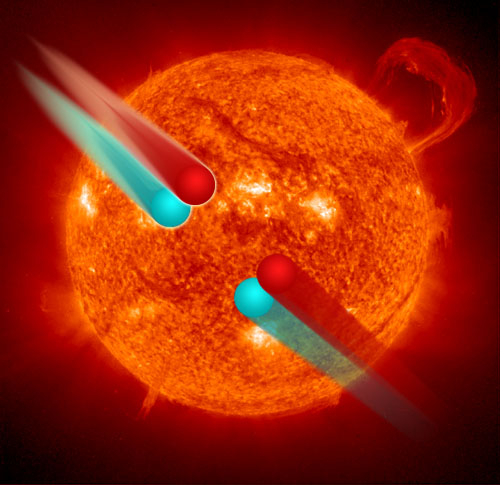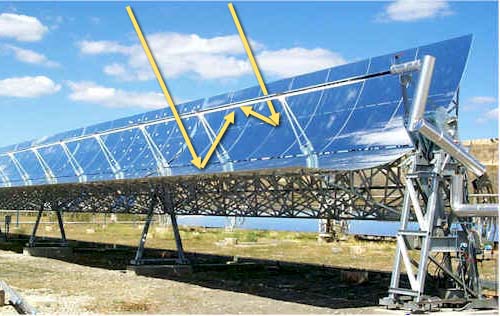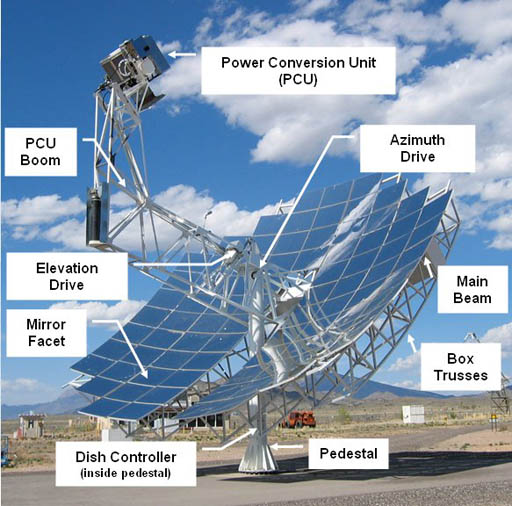|
Where
do we get energy? |
| In the earlier tutorial on energy, you saw pictures of Lake Mead, a locomotive,
and a weight lifter. But where did the energy come from that gave the water
in Lake Mead the potential energy to generate electricity at the dam? Where
did the locomotive get the diesel to power its engines? Where did the weight
lifter get his food and the calories to lift the barbell? |
| Our Sun is the ultimate
source of energy that we use here on Earth. The rain that filled Lake Mead
came from solar energy evaporating water from the oceans. The diesel for
the train came from plants that grew with the Sun's energy and eventually
became petroleum. The weight lifter got his calories from meat and plants.
The plants got the energy from the Sun, and the meat came from animals that
ate plants that got energy from the Sun. |
|
The below picture shows the Sun and Earth and the distance
between them to proper scale. If a viewer is far enough back to see the
Sun and Earth together, the Sun on the left is visible, but the Earth appears
as another dot against the stars in the background. The temperature of space
is colder than 400 degrees Fahrenheit below zero. Without the Sun, not only
would the Earth's oceans freeze solid, the air in the atmosphere would freeze
solid as well. |
|
|
|
Considering
the distance and relative small size of Earth, it's surprising that we
get so much energy from the sun. Fortunately... |
|
|
|
The Sun radiates huge amounts of energy
in the form of visible light, infrared light (heat light), ultraviolet,
and X-rays. Earth intercepts less than one trillionth of this energy.
In other words, the Sun puts out enough energy to satisfy 2,000,000,000,000
(2 trillion) Earths. |
|
|
The picture on the left was taken
from the surface of Mars. Earth is seen as a small dot. Mars is about 1
and a half times the distance Earth is from the Sun, which means Mars get
less than half the energy from the Sun than Earth does. The polar ice caps
of Mars are made from "dry ice" (frozen carbon dioxide) not water
ice.
 |
|
Even though the Sun is the original source
of energy, we use different forms of energy that was made possible by
the Sun. They are the following: |
| FOSSIL FUELS: Fossil fuels get their name because
they formed from microscopic plants millions of years ago (see pic below).
Fossil fuels include natural gas, coal, and the fractions of petroleum such
as gasoline, oil, diesel fuel, propane, butane, and tar. Nature has taken
60 to 300 million years to make these fuels, but we might use them up in
17 to 70 years from now, depending on future consumption. |
|
|
|
Wind power
is a growing source of renewable energy. Fossil fuels are not renewable
(unless we can wait 100 million years). But wind power renews itself every
day as the Sun energy creates uneven heating and wind is produced. California
has been using wind power for quite awhile and Texas has the largest wind farm in the world. Arizona has just finished its first
wind farm this year near the northeastern town of Snowflake. I have a trailer
in a town not too far from there and will vouch for the high winds that come through there. Many
of my neighbors use wind generators. |
|
|
NUCLEAR POWER makes
up a small fraction of the power in the US; however, the Palo Verde nuclear
plant near Phoenix is responsible for a large percent of Phoenix's electrical
power. |
|
NUCLEAR FUSION is the Holy Grail of power sources. The fuel source is two deuterium atoms (hydrogen nucleus of one proton and one neutron instead of the normal hydrogen atom that doesn't have any neutron). Out of every 100,000 hydrogen atoms, there are 15 deuterium atoms. Hydrogen is most easily found in water. An olympic size pool has about 600,000 gallons. That means 90 of those gallons will have water with a deuterium attached. Those deuterium atoms can be split off using electrolysis and then fed into the nuclear fusion reactor. So far the fusion of these nuclei have produced power but not as much that was required to create the fusion. Some researchers think we are about 3 years away from creating a fusion power source that puts out more power than it uses. If true, we will have an abundance of power from water. |
|
SOLAR
ENERGY captured with photovoltaic
cells (solar cells). Photovoltaic gets its name because the energy
of light (photo) is used to create voltage
(voltaic). Photovoltaic cells offer a simple
way to get electricity, at least DC (direct current) electricity used in
charging batteries. The problem with photovoltaic cells is that they are
expensive because the making of a solar cell is similar to making a computer chip. There are some new designs that make flexible thin films of solar material in the same way newspapers are printed. Those promise to bring the costs down even though that hasn't happened yet. Photovoltaic cells convert about 15% to 20%
of the sunlight into electricity. |
|
Another approach
of using the Sun's energy is to focus the heat from the Sun (infrared light)
onto a tube filled with oil. The heated oil is then pumped to an adjacent
generating plant that uses the heat to make steam, which then pushes on
turbines hooked to electric generators. The polished metal reflectors are
cheaper than photovoltaic cells. Even though these panels are fairly simple,
you must have steam-powered turbines and electrical generators attached
to these collectors. |
|
|
When done on a large
scale, thousands or millions of watts of electricity can be generated from
the free energy of the Sun. Even though the energy is free from the Sun,
it takes about 20 to 30 years to recover the cost of setting up a solar
power station. But one good thing about solar is that in hot climates it
produces the most energy at the time it is needed the most-- midday air
conditioning. |
|
Solar Powered Sterling Engine:. A Sterling Engine is a piston driven engine where the gas is heated from the outside of the piston's cylinder rather than from gasoline burning inside of the cylinder.
The Power Conversion Unit shown is like a 4 cylinder car engine except instead of combustion of gasoline causing pressure in the cylinders, heat from the sun heating helium gas provides pressure in the cylinders that push on the pistons. The pistons turn a crankshaft hooked to an electric generator. This type of solar energy conversion to electricity sets the record for efficiency. About 31% of the sun's energy gets converted to electricity. 60 of these dishes are at a power station in Peoria, Arizona. At 25,000 watts each, that totals 1.5 million watts. |
|
|
Passive Solar
Heating. We should also include passive solar heating. They are extremely efficient.
The panels are not photovoltaic cells; they are just black metal behind
panes of glass. Air, water, or an antifreeze solution passes next to the dark metal that gets
hot from the Sun. The hot air, hot water, or hot antifreeze brought into the home to heat the home or to
assist the hot water heater. They are much cheaper than photovoltaic panels. So this is a much better way to create heat in the home versus generating electricity and using it to run a space heater or electric water heater. |
|
|
Animal Power:
Lest we forget, for the majority of mankind's history, the source of power
for the chores we had to do was our own body's power plus maybe that of
an animal. This was pretty much the limit of our energy consumption. Cooking
was done with wood or animal dung. |
|
|
PonyPower vs.
HorsePower: Before the days of machine power, mines
used ponies to pull carts of coal or ores or to turn pulleys to lift the
coal or ore to the surface. Ponies could lift 220 lbs 100 feet in about
a minute. Energy can be defined as force times distance. So here the force
to overcome is 220 lbs, and the distance is 100 feet. So the energy is 220lbs
x 100 ft = 22,000 ft-lbs. Power is energy consumption within a set amount
of time. Here it would be 22,000 ft-lbs per minute. James Watt, the inventor
of the new steam engine wanted his engines compared to power of horses,
which people were accustomed to. |
|
|
James Watt knew the power of ponies
was about 22,000 ft-lbs per minute. He figured a full-size horse would
be about 50% stronger, meaning it could lift 330 lbs 100 feet per minute
(33,000 ft-lbs. per min). So that became the definition of one horsepower.
A ten horsepower steam engine could do the lifting of 10 horses (or 15 ponies). |
| Human Power:
A friend of mine, Paul Walters, was hired to be a bicyclist at the Mountain
Dew Amp drink event at SuperBowl 42. They had forty-two bicyclists
pedal for 12 hours per day for total of four days. |
|
|
|
|
Human Power:
Each bike had their rear tire in contact with a generator.
So as the bicyclist pedaled they produced electricity. |
|
|
AMP Drink Power:
The purpose of the event is to show all these bicyclist getting energy
from guzzling the high sugar, high caffeine, high herbal stimulant liquid.
All this to provide power for the pregame show. What a great idea... |
|
|
Human to Electrical Power: Large
banks of batteries captured all of this energy from the 42 bicyclists
pedaling 12 hours a day for 4 days.
Cash in the Power: At
the end of 4 days and hundreds of Amp drinks, a meter had kept track of
the total amount of energy generated. Remember, it amounted to 42 athletic
bicyclists pedaling 12 hours a day for four days. That multiplies out to
be equivalent to 2,016 hours of one bicyclist pedaling. |
|
|
The electric meter reads 38 kilowatt-hours, which can
be interpreted as 38 kilowatts for one hour (like 10 air conditioners running
for one hour) or 1 kilowatt (like a toaster) running for 38 hours. At
a cost of about 8 cents per kilowatt-hour, all of this effort produced
only 3 dollars of electricity! Yes, only
3 dollars of electricity. This either means that electricity is terribly
cheap or that we humans are very
weak power sources.
What scares me is if we had to depend on our own legs
to create electricity, we are in big trouble. Look at how many watts we
can maintain. 38 kilowatt-hours = 38,000 watt-hours. Divide this by 2,016
hours of bicycling, we get about 19 watts. In other words, if we had an
athletic bicyclist pedaling away all day, we could only operate electronic
devices with 19 watts or less. We would have to have 5 bicyclists just
to turn on one 100 watt bulb. So without alternative power, our society
would quickly revert back to the days of horse drawn carriages and horse
powered everything. |
To evaluate any power source, it's important to do the calculations to see if the power output is worth the cost. The example above about bicyclists producing power lets us know that human power is not a good choice unless it's a low power device.
In doing calculations regarding energy sources just realize there's a lot of conversions between power and energy units such as watts, joules, calories, BTU's, foot-pounds, and horsepower. The online conversion web sites even have gallons of various fuels as units of energy, which makes it easy to convert gallons of gas to kilowatt-hours. Just use dimensional analysis to do the conversions. With these skills you can explore and evaluate the energy use and solutions. |
 |
For example, I was at a new fast food restaurant recently and saw about forty 50-watt flood lamps in the dining area. That's 2000 watts. During the summer, the air conditioner has to cool down all of the hot air these create. So the owners have to pay twice. Once to light the bulbs and again to cool the air that is heated by the bulbs. So that 4,000 watts of energy to use these bulbs. They are open 15 hours a day, so that's 4,000wattsx15hrs = 60 kilowatt-hours per day. In a month that's 1800 kilowatt-hours. At around 10 cents per kilowatt-hr, that's about $180 dollars for just these lights in the dining area. Compact fluorescent bulbs would reduce that to about $25 a month and LED bulbs would reduce it to about $9 a month. So in addition to understanding energy sources, it's just as important to know how to save the energy we have by using more efficient devices. |





















